Assessing the Ability of the DDES Turbulence Modeling Approach to Simulate the Wake of a Bluff Body
Abstract
:1. Introduction
2. Methodology
2.1. Turbulence Modeling
2.2. Case Description and Numerics
3. Results and Discussion
3.1. Vortex Shedding
3.2. Time-Averaged Velocity Component
3.3. Time-Varying Velocity Component
3.4. Integral Flow Quantities
4. Conclusions and Outlook
Acknowledgments
Author Contributions
Conflicts of Interest
Abbreviations
| CFD | computational fluid dynamics |
| DDES | delayed detached-eddy simulation |
| DES | detached-eddy simulation |
| LES | large eddy simulation |
| RANS | Reynolds-averaged Navier–Stokes |
| rms | root mean square |
| URANS | unsteady Reynolds-averaged Navier–Stokes |
References
- Muscari, R.; Di Mascio, A.; Verzicco, R. Modeling of vortex dynamics in the wake of a marine propeller. Comput. Fluids 2013, 73, 65–79. [Google Scholar] [CrossRef]
- Spalart, P.R. Strategies for turbulence modelling and simulations. Int. J. Heat Fluid Flow 2000, 21, 252–263. [Google Scholar] [CrossRef]
- Spalart, P.R. Detached-Eddy Simulation. Annu. Rev. Fluid Mech. 2009, 41, 181–202. [Google Scholar] [CrossRef]
- Shur, M.; Spalart, P.R.; Squires, K.D.; Strelets, M.; Travin, A. Three Dimensionality in Reynolds-Averaged Navier-Stokes Solutions Around Two-Dimensional Geometries. AIAA J. 2005, 43, 1230–1242. [Google Scholar] [CrossRef]
- Najjar, F.; Balachandar, S. Low-frequency unsteadiness in the wake of a normal flat plate. J. Fluid Mech. 1998, 370, 101–147. [Google Scholar] [CrossRef]
- Spalart, P.R.; Deck, S.; Shur, M.L.; Squires, K.D.; Strelets, M.; Travin, A. A new version of detached-eddy simulation, resistant to ambiguous grid densities. Theor. Comput. Fluid Dyn. 2006, 20, 181–195. [Google Scholar] [CrossRef]
- Paik, J.; Sotiropoulos, F.; Porté-Agel, F. Detached eddy simulation of flow around two wall-mounted cubes in tandem. Int. J. Heat Fluid Flow 2009, 30, 286–305. [Google Scholar] [CrossRef]
- Nasif, G.; Barron, R.; Balachandar, R. DES evaluation of near-wake characteristics in a shallow flow. J. Fluids Struct. 2014, 45, 153–163. [Google Scholar] [CrossRef]
- Muld, T.W.; Efraimsson, G.; Henningson, D.S.; Herbst, A.H. Analysis of flow structures in the wake of a high-speed train. In The Aerodynamics of Heavy Vehicles III. Lecture Notes in Applied and Computational Mechanics; Springer: Cham, Switzerland, 2016; Volume 79, pp. 3–19. [Google Scholar]
- Felli, M.; Camussi, R.; Di Felice, F. Mechanisms of evolution of the propeller wake in the transition and far fields. J. Fluid Mech. 2011, 682, 5–53. [Google Scholar] [CrossRef] [Green Version]
- Boudreau, M.; Dumas, G. Comparison of the wake recovery of the axial-flow and cross-flow turbine concepts. J. Wind Eng. Ind. Aerodyn. 2017, 165, 137–152. [Google Scholar] [CrossRef]
- Wilcox, D. Turbulence Modeling for CFD, 2nd ed.; DCW Industries, Inc.: Flintridge, CA, USA, 1998. [Google Scholar]
- Lyn, D.A.; Einav, S.; Rodi, W.; Park, J.H. A laser-Doppler velocimetry study of ensemble-averaged characteristics of the turbulent near wake of a square cylinder. J. Fluid Mech. 1995, 304, 285–319. [Google Scholar] [CrossRef]
- Voke, P.R. Flow Past a Square Cylinder: Test Case LES2. In Direct and Large-Eddy Simulation II; ERCOFTAC Series; Chollet, J.P., Voke, P., Kleiser, L., Eds.; Springer: Dordrecht, The Netherlands, 1997; Volume 5, pp. 355–373. [Google Scholar]
- Rodi, W.; Ferziger, J.H.; Breuer, M.; Pourquiée, M. Status of Large Eddy Simulation: Results of a Workshop. J. Fluids Eng. 1997, 119, 248–262. [Google Scholar] [CrossRef]
- Fureby, C.; Tabor, G.; Weller, H.; Gosman, A. Large Eddy Simulations of the Flow Around a Square Prism. AIAA J. 2000, 38, 442–452. [Google Scholar] [CrossRef]
- Moussaed, C.; Wornom, S.; Salvetti, M.V.; Koobus, B.; Dervieux, A. Impact of dynamic subgrid-scale modeling in variational multiscale large-eddy simulation of bluff-body flows. Acta Mech. 2014, 225, 3309–3323. [Google Scholar] [CrossRef]
- Schmidt, S. Grobstruktursimulation Turbulenter Strömungen in Komplexen Geometrien und bei Hohen Reynoldszahlen; Mensch Mensch & Buch-Verlag: Berlin, Germany, 2000. [Google Scholar]
- Sohankar, A.; Norberg, C.; Davidson, L. Large Eddy Simulation of Flow Past a Square Cylinder: Comparison of Different Subgrid Scale Models. J. Fluids Eng. 2000, 122, 39–47. [Google Scholar] [CrossRef]
- Barone, M.; Roy, C. Evaluation of Detached Eddy Simulation for Turbulent Wake Applications. AIAA J. 2006, 44, 3062–3071. [Google Scholar] [CrossRef]
- Schmidt, S.; Thiele, F. Comparison of numerical methods applied to the flow over wall-mounted cubes. Int. J. Heat Fluid Flow 2002, 23, 330–339. [Google Scholar] [CrossRef]
- Pope, S. Turbulent Flows; Cambridge University Press: Cambridge, UK, 2000. [Google Scholar]
- Spalart, P.R.; Allmaras, S.R. One-Equation Turbulence Model for Aerodynamic Flows. La Recherche Aérospatiale 1994, 1, 5–21. [Google Scholar]
- Travin, A.; Shur, M.; Strelets, M.; Spalart, P.R. Detached-Eddy Simulations Past a Circular Cylinder. Flow Turbul. Combust. 2000, 63, 293–313. [Google Scholar] [CrossRef]
- Breuer, M.; Jovicic, N.; Mazaev, K. Comparison of DES, RANS and LES for the separated flow around a flat plate at high incidence. Int. J. Numer. Methods Fluids 2003, 41, 357–388. [Google Scholar] [CrossRef]
- Shur, M.; Spalart, P.R.; Strelets, M.; Travin, A. Detached-eddy simulation of an airfoil at high angle of attack. Eng. Turbul. Model. Exp. 1999, 4, 669–678. [Google Scholar]
- Spalart, P.R.; Jou, W.; Strelets, M.; Allmaras, S. Comments on the Feasibility of LES for Wings, and on a Hybrid RANS/LES Approach. In Proceedings of the International Conference on DNS/LES, Ruston, LA, USA, 4–8 August 1997. [Google Scholar]
- Garbaruk, A.; Leicher, S.; Mockett, C.; Spalart, P.R.; Strelets, M.; Thiele, F. Evaluation of time sample and span size effects in DES of nominally 2D airfoils beyond stall. Notes on Numerical Fluid Mechanics and Multidisciplinary Design. In Progress in Hybrid RANS-LES Modelling; Springer: Berlin/Heidelberg, Germany, 2010; Volume 111, pp. 87–99. [Google Scholar]
- OpenCFD. OpenFOAM-The Open Source CFD Toolbox—User’s Guide, 2.1 ed.; OpenCFD Ltd.: London, UK, 2012. [Google Scholar]
- Ferziger, J.H.; Perić, M. Computational Methods for Fluid Dynamics; Springer: Berlin/Heidelberg, Germany, 2002. [Google Scholar]
- Spalart, P.R. Young-Person’s Guide to Detached-Eddy Simulation Grids; Technical Report; NASA Technical Reports Server: Hampton, VA, USA, 2001.
- Mockett, C.; Perrin, R.; Reimann, T.; Braza, M.; Thiele, F. Analysis of Detached-Eddy Simulation for the Flow Around a Circular Cylinder with Reference to PIV Data. Flow Turbul. Combust. 2010, 85, 167–180. [Google Scholar] [CrossRef]
- Jeong, J.; Hussain, F. On the identification of a vortex. J. Fluid Mech. 1995, 285, 69–94. [Google Scholar] [CrossRef]
- Williamson, C.H.K. Vortex Dynamics in the Cylinder Wake. Annu. Rev. Fluid Mech. 1996, 28, 477–539. [Google Scholar] [CrossRef]
- Celik, I.; Cehreli, Z.; Yavuz, I. Index of Resolution Quality for Large Eddy Simulations. J. Fluids Eng. Trans. ASME 2005, 127, 949–958. [Google Scholar] [CrossRef]
- Gousseau, P.; Blocken, B.; Van Heijst, G.J.F. Quality assessment of Large-Eddy Simulation of wind flow around a high-rise building: Validation and solution verification. Comput. Fluids 2013, 79, 120–133. [Google Scholar] [CrossRef]
- Klein, M. An Attempt to Assess the Quality of Large Eddy Simulations in the Context of Implicit Filtering. Flow Turbul. Combust. 2005, 75, 131–147. [Google Scholar] [CrossRef]
- Meyers, J.; Geurts, B.J.; Baelmans, M. Database analysis of errors in large-eddy simulation. Phys. Fluids 2003, 15, 2740–2755. [Google Scholar] [CrossRef] [Green Version]
- Mannini, C.; Šoda, A.; Schewe, G. Numerical investigation on the three-dimensional unsteady flow past a 5:1 rectangular cylinder. J. Wind Eng. Ind. Aerodyn. 2011, 99, 469–482. [Google Scholar] [CrossRef]
- Bearman, P.; Obasaju, E. An Experimental Study of Pressure Fluctuations on Fixed and Oscillating Square-Section Cylinders. J. Fluid Mech. 1982, 119, 297–321. [Google Scholar] [CrossRef]
- Norberg, C. Flow around rectangular cylinders: Pressure forces and wake frequencies. J. Wind Eng. Ind. Aerodyn. 1993, 49, 187–196. [Google Scholar] [CrossRef]
- Blevins, R. Applied Fluid Dynamics Handbook; Krieger Publishing Company: Malabar, FL, USA, 1992. [Google Scholar]

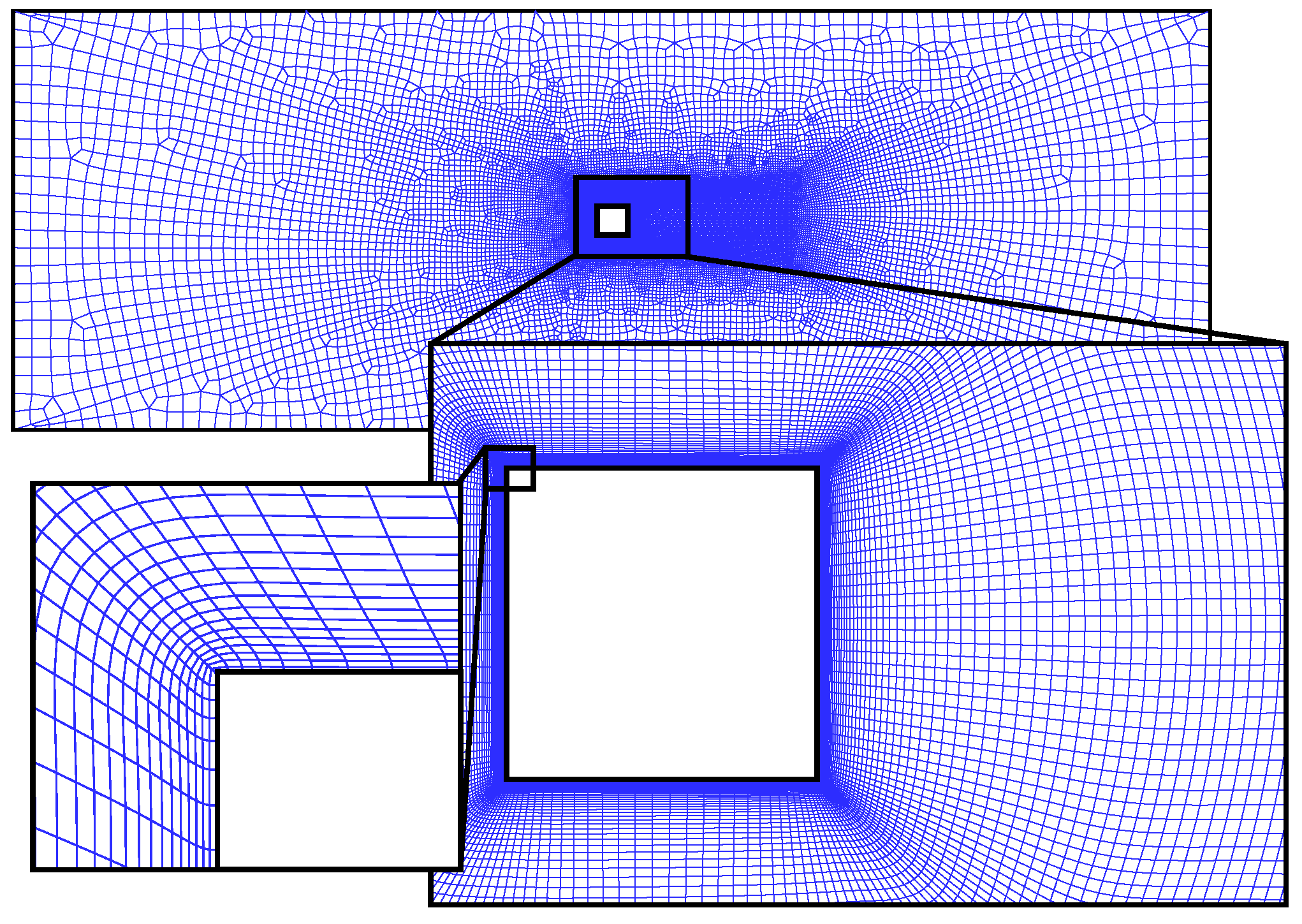
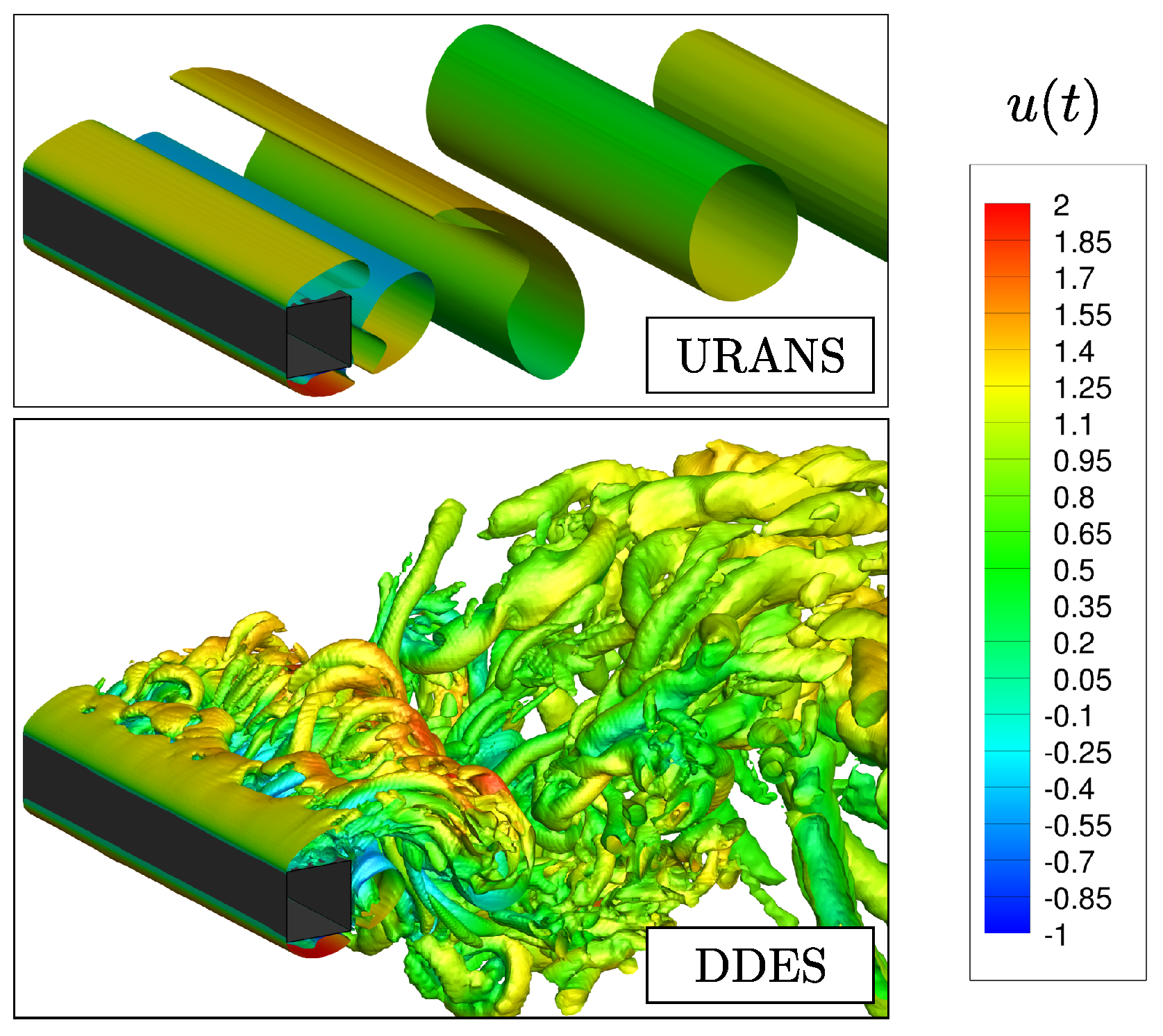
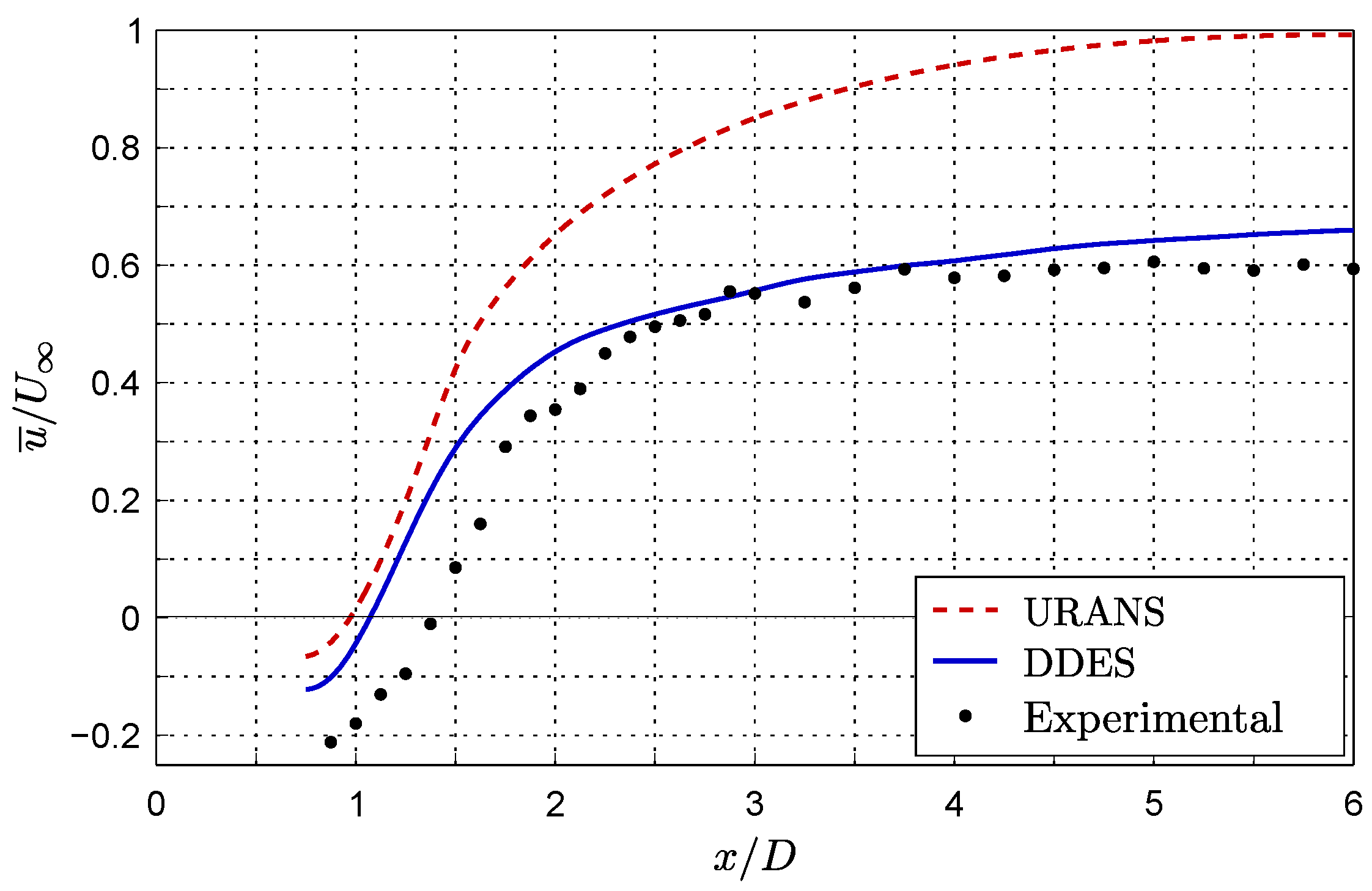

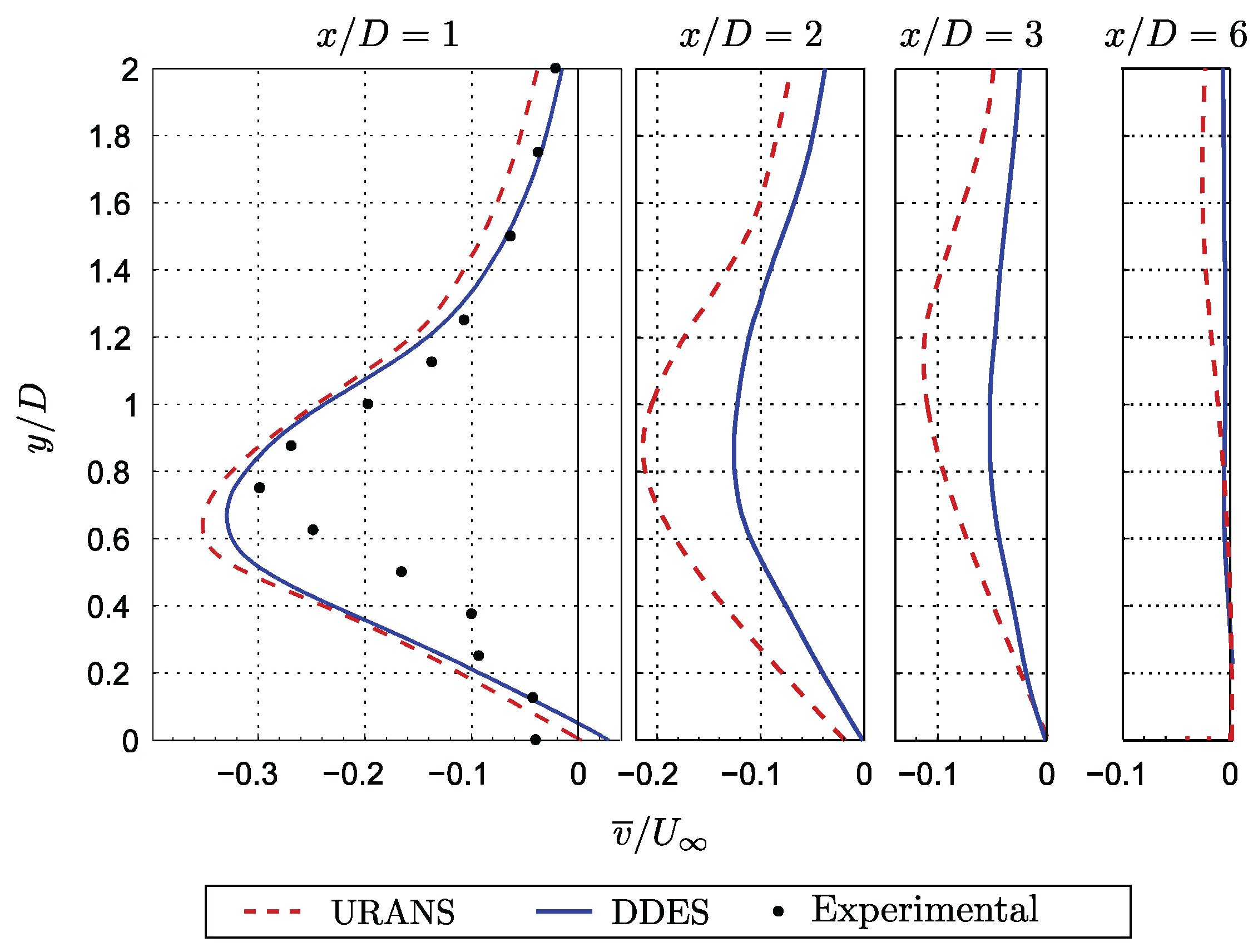
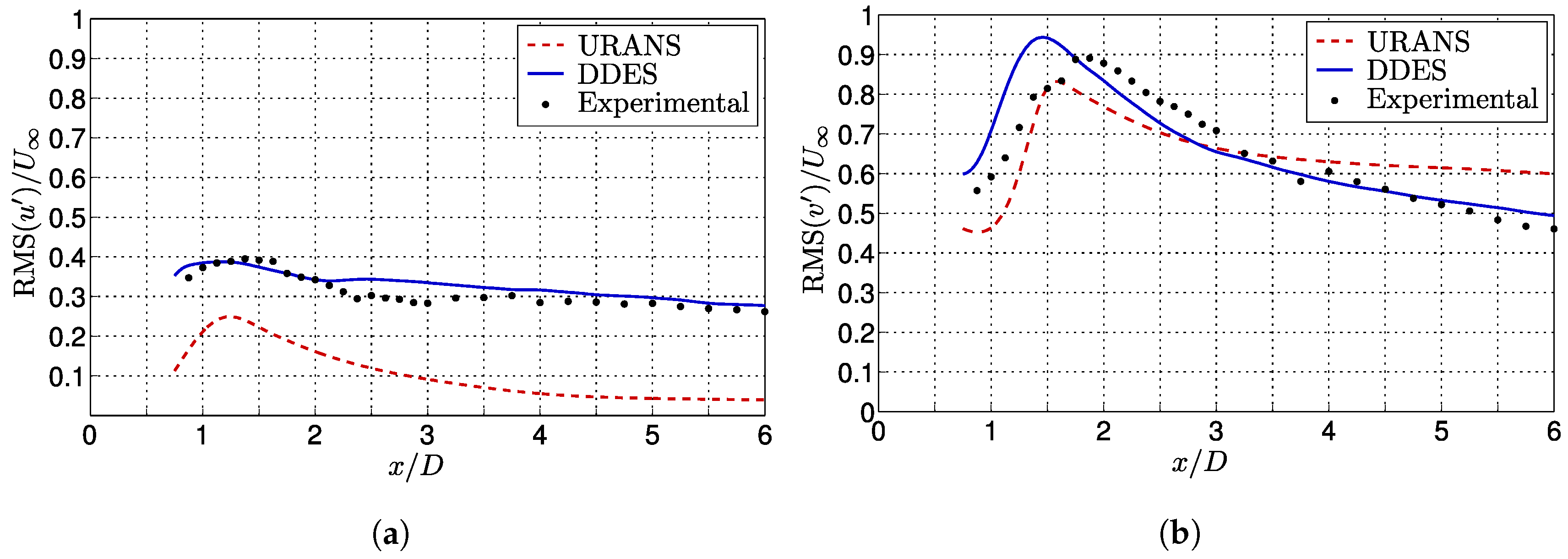
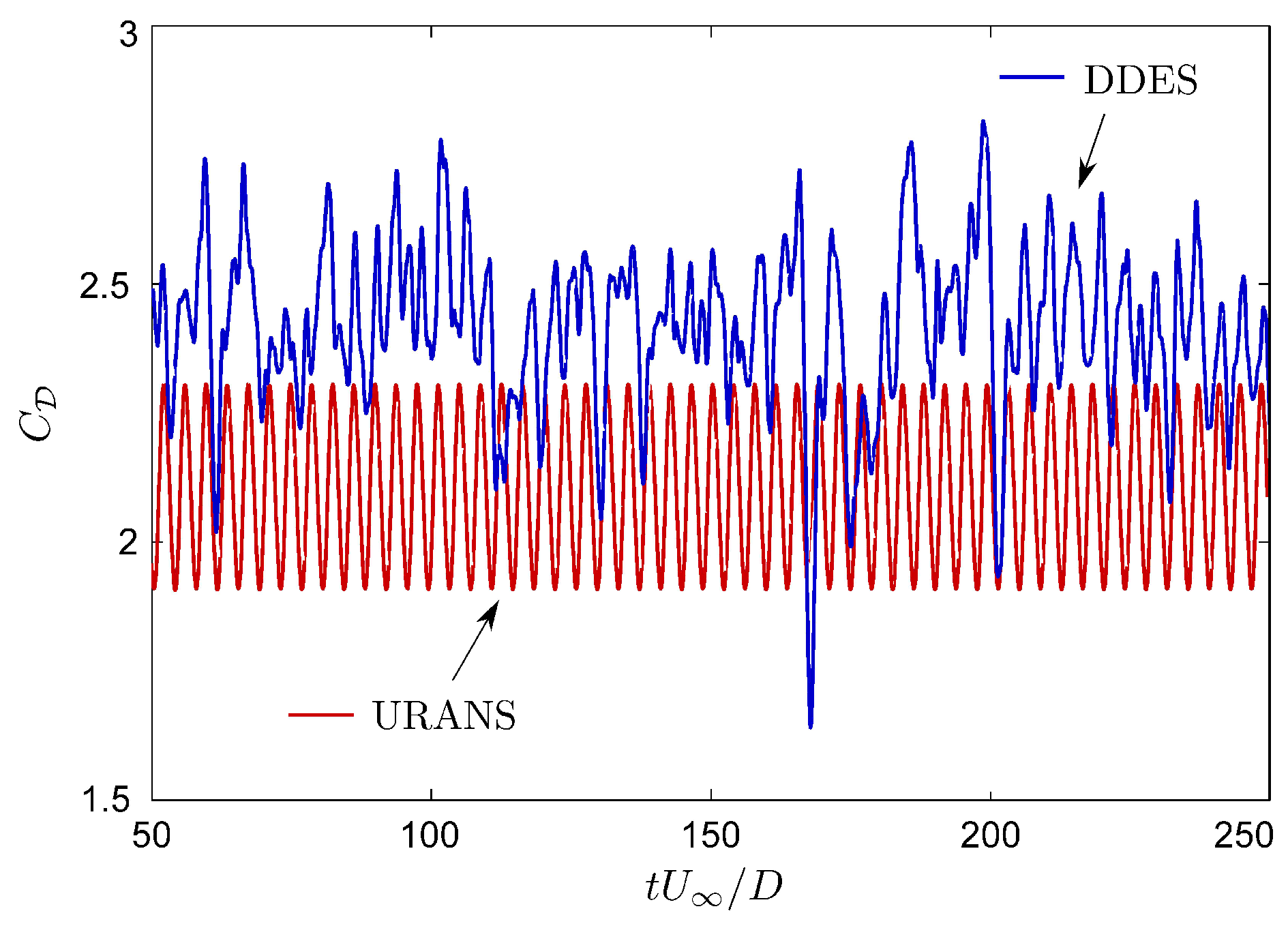
| Case | |||
|---|---|---|---|
| URANS | 0.05 | 0.01 | 209.5 |
| DDES | 0.05 | 0.01 | 1507.5 |
| Source | AR | |||||
|---|---|---|---|---|---|---|
| Current study | ||||||
| URANS | 7 | 2.11 | 0.133 | 0.97 | 0.14 | 1.56 |
| DDES | 3 | 2.36 | 0.123 | 1.20 | 0.26 | 1.50 |
| DDES | 5 | 2.40 | 0.126 | 1.15 | 0.21 | 1.51 |
| DDES | 7 | 2.41 | 0.126 | 1.07 | 0.17 | 1.47 |
| DES simulations | ||||||
| Barone/Roy [20] | 4 | 2.36 * | 0.131 * | 1.42 | 0.29 * | 1.30 * |
| Schmidt/Thiele [21] | 4 | 2.42 | 0.13 | 1.16 | 0.28 | 1.55 |
| LES simulations | ||||||
| Fureby et al. [16] | 8 | 2.0–2.2 | 0.129–0.135 | 1.23–1.37 | 0.17–0.20 | 1.30–1.34 |
| Moussaed et al. [17] | 2.06 | 0.128 | ≈1.3 | 0.24 | 1.28 | |
| Schmidt [18] | 4 | 2.18 | 0.13 | 1.07 | 0.19 | 1.47 |
| Sohankar et al. [19] | 4 | 2.03–2.32 | 0.126–0.132 | ≈1 | 0.16–0.20 | 1.23–1.54 |
| Rodi et al. [15] | 4 | 1.86–2.77 | 0.09–0.15 | 0.89–2.96 | 0.10–0.27 | 0.38–1.79 |
| Voke [14] | 4 | 2.03–2.79 | 0.13–0.16 | 1.02–1.61 | 0.12–0.36 | 1.01–1.68 |
| Experiments | ||||||
| Bearman/Obasaju [40] | 17 | 2.35 * | 0.135 * | - | - | 1.34 |
| Lyn et al. [13] | 9.75 | 2.1 | 0.132 | 1.38 | - | - |
| Norberg [41] | 51 | 2.35 * | 0.135 * | - | - | - |
© 2017 by the authors. Licensee MDPI, Basel, Switzerland. This article is an open access article distributed under the terms and conditions of the Creative Commons Attribution (CC BY) license (http://creativecommons.org/licenses/by/4.0/).
Share and Cite
Boudreau, M.; Dumas, G.; Veilleux, J.-C. Assessing the Ability of the DDES Turbulence Modeling Approach to Simulate the Wake of a Bluff Body. Aerospace 2017, 4, 41. https://doi.org/10.3390/aerospace4030041
Boudreau M, Dumas G, Veilleux J-C. Assessing the Ability of the DDES Turbulence Modeling Approach to Simulate the Wake of a Bluff Body. Aerospace. 2017; 4(3):41. https://doi.org/10.3390/aerospace4030041
Chicago/Turabian StyleBoudreau, Matthieu, Guy Dumas, and Jean-Christophe Veilleux. 2017. "Assessing the Ability of the DDES Turbulence Modeling Approach to Simulate the Wake of a Bluff Body" Aerospace 4, no. 3: 41. https://doi.org/10.3390/aerospace4030041





